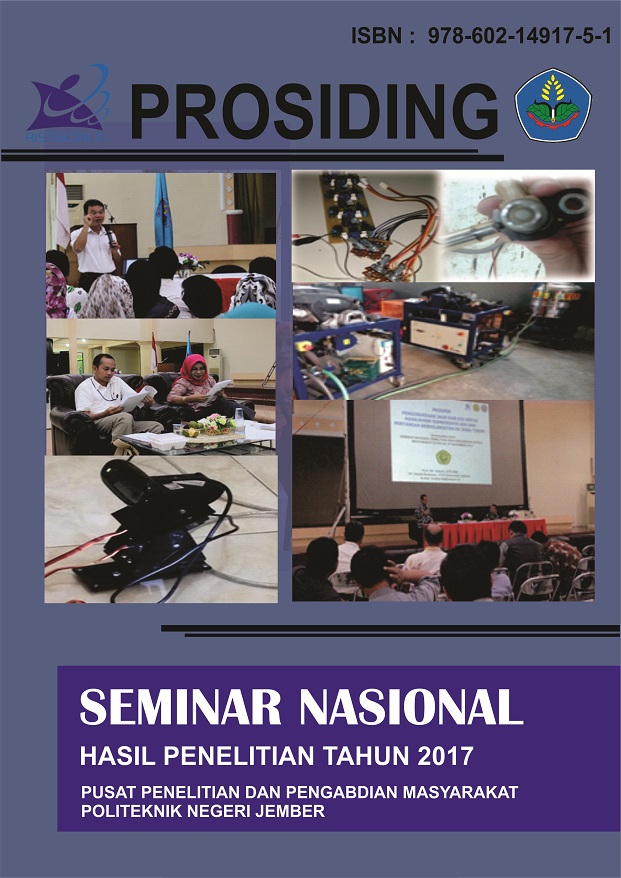Optimasi Kadar Total Penol dan Aktivitas Antioksidan Tepung Labu Kuning Menggunakan Response Surface Methodology (RSM)
Abstract
Yellow pumpkin (Cucurbita moscata) is a local plant that is yet optimally utilized. It has been reported that drying temperature and pre-treatment of metabisulfite greatly affected the total phenolic contents and antioxidant activity of pumpkin flour. Response Surface Methodology (RSM) considered to be a powerful tool to optimize process conditions in order to get a high yield of particular response. Process optimization was done based on the Box-Behnken construction that consisted of 12 factorial treatments and 5 replicates of central point treatments. Factorial treatment as an independent variable were immersion of meta-bisulfite (15-45 min), temperature of draying (75-85oC), and duration of drying (8-12 h). Based on the data acquired by Box-Behnken Design, a quadratic model can predict the response at any point. The response variables correlated well with the independent variables according to the multiple regression analysis. The R2 of the model fitted for total phenolic content and DPPH scavenging activity was 0.9171 and 0.9746, respectively. Based on the model, the optimum conditions for manufacturing of pumpkin flour were 15 min of immersion of meta-bisulfite, 83.03 oC of drying temperature, and 10.04 h of drying time. Those optimized conditions produced pumpkin flour which has predicted total phenolic content of 1.83 mg GAE/g sample and DPPH scavenging activity of 91.072%.
Â
Keywords— antioxidant, flour, RSM, pumpkin
References
Rakcejeva, T., Galoburda, R., Cude, L., & Strautniece, E. (2011). Use of dried pumpkins in wheat bread production. Procedia Food Science, 1, 441–447. doi:10.1016/j.profoo.2011.09.068
Jacobo-Valenzuela, N., Maróstica-Junior, M. R., Zazueta-Morales, J. D. J., and Gallegos-Infante, J. A. (2011). Physicochemical, technological properties, and health-benefits of Cucurbita moschata Duchense vs. Cehualca. Food Research International, 44(9), 2587–2593. doi:10.1016/j.foodres.2011.04.039
Box, G. and Wilson, K. (1951). On the experimental attainment of optimum conditions. J. R. Stat. Soc. 13: 1-45.
Guiné R.P.F., Pinho S. and Barroca M.J. (2010). Study of the convective drying of pumpkin (Cucurbita maxima). Food and Bioproducts Peocessing. 89 (4): 422-428.
Aydin, E., & Gocmen, D. (2015). The influences of drying method and metabisulfite pre-treatment on the color, functional properties and phenolic acids contents and bioaccessibility of pumpkin flour. LWT - Food Science and Technology, 60(1), 385–392. doi:10.1016/j.lwt.2014.08.025
Mohamed, S., and Hussein, R. (1994). Effect of low temperature blanching, cysteine-HCl, N-acetyl-L-cysteine, Na metabisulphite, and drying temperature on the firmness and nutrient content of dried carrots. Journal of Food Processing and Preservation, 18(4), 343e348.
Chen, J. P., Tai, C. Y., & Chen, B. H. (2007). Effects of different drying treatments on the stability of carotenoids in Taiwanese mango (Mangifera indica L.). Food Chemistry, 100(3), 1005e1010.
Hadiyat, M.A. (tth). Response-surface dan Taguchi : Sebuah alternatif atau kompetisi dalam optimasi secara praktis. Jurusan Teknik Industri, Ubaya.
Salinas, M. V., & Puppo, M. C. (2015). Optimization of the formulation of nutritional breads based on calcium carbonate and inulin. LWT - Food Science and Technology, 60(1), 95–101. doi:10.1016/j.lwt.2014.08.019
Guo, N., Gong, F., Chi, Z., Sheng, J., and Li, J. (2009). Enhanced inulinase production in solid state fermentation by a mutant of the marine yeast Pichia guilliermondii using surface response methodology and inulin hydrolysis. Journal of Industrial Microbiology and Biotechnology, 36(4), 499–507. doi:10.1007/s10295-008-0519-2
Hadiyanto, H., and Suttrisnorhadi, S. (2016). Response Surface Optimization of Ultrasound Assisted Extraction (UAE) of Phycocyanin from Microalgae Spirulina platensis. Emirates Journal of Food and Agriculture, 28(4), 1. doi:10.9755/ejfa.2015-05-193
PeriÄin, D., Radulović-Popović, L., VaÅ¡tag, Ž., Madarev-Popović, S., and Trivić, S. (2009). Enzymatic hydrolysis of protein isolate from hull-less pumpkin oil cake: Application of response surface methodology. Food Chemistry, 115(2), 753–757. doi:10.1016/j.foodchem.2008.12.040
Vuong, Q. V., Golding, J. B., Nguyen, M. H. and. Roach, P. D. (2012). Production of caffeinated and decaffeinated green tea catechin powders from underutilised old tea leaves. Journal of Food Engineering. 110: 1-8.
Que, F., Mao, L., Fang, X., &Wu, T. (2008). Comparison of hot air-drying and freeze- drying on the physicochemical properties and antioxidant activities of pumpkin (Cucurbita moschata Duch.) flours. International Journal of Food Science and Technology, 43,1195e1201.
Singleton, V. L., & Rossi, J. J. A. (1965). Colorimetric of total phenolics with phosphomolybdic–phosphotungstic acid reagents. American Journal of Enology and Viticulture, 16, 144–158.
Shahidi, F., Liyana-Pathirana, C. M., & Wall, D. S. (2006). Antioxidant activity of white and black sesame seeds and their hull fractions. Food Chemistry, 99, 478–483.
Zhang, Q. A., Z. Q. Zhang, X. F. Yue, X. H. Fan, T. Li S. F. Chen. 2009. Response surface optimization of ultrasound-assisted oil extraction from autoclaved almond powder. Food Chem. 116: 513-518.
Ibrahim, U. K., Austin, E. A., & Salleh, R. M. (2015). Effect of Drying Temperature and Time on Antioxidant and Total Phenolic Content in Garcinia Mangostana Pericarp, 1113, 279–284. https://doi.org/10.4028/www.scientific.net/AMR.1113.279

